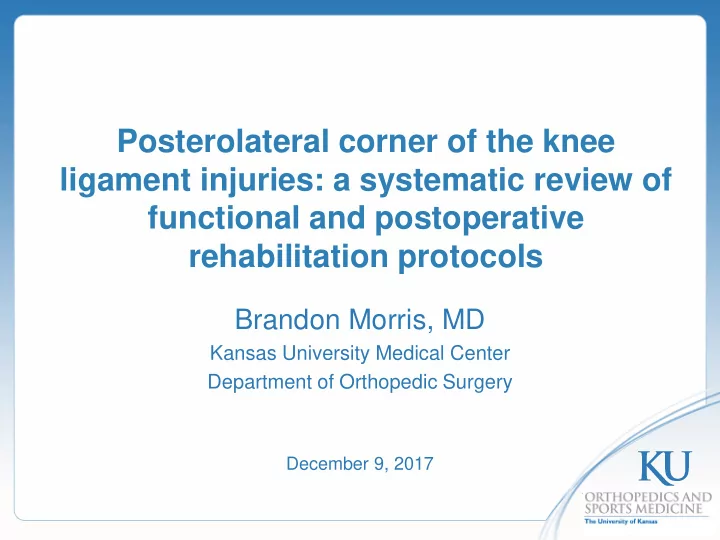

Posterolateral corner of the knee ligament injuries: a systematic review of functional and postoperative rehabilitation protocols Brandon Morris, MD Kansas University Medical Center Department of Orthopedic Surgery December 9, 2017
Acknowledgements • Research Team Bryan G. Vopat, MD J. Paul Schroppel, MD Scott Mullen, MD Brandon Barnds, MD Kenneth Kim, MD Armin Tarakemeh, BS
Disclosures No conflicts of interest to disclose
Introduction • Posterolateral Corner of the Knee Injury - Optimal function and rehabilitation protocol? - Evidence or expert opinion based? - Systematic literature review
PLC Injury Epidemiology PLC complex consists of: • LCL(FCL) ligament • Popliteofibular ligament • Popliteus PLC complex imparts dynamic and static knee stabilization Isolated PLC injury accounts for approximately 2% of all knee ligament injuries
Rehabilitation • Rehabilitation Goals – Protect ligament reconstruction – Preserve joint ROM – Promote active recovery • Variations on Rehabilitation – How much joint ROM to allow and when? – When to advance WB status?
Purpose • To determine what type of rehabilitation protocol (accelerated WB versus NWB) leads to better outcomes after isolated PLC injuries
Methods • Systematic review of the literature – PubMed search using terms: • “Posterolateral corner” and “rehabilitation” - Inclusion criteria: isolated PLC reconstruction with description of postoperative protocol - Exclusion criteria: isolated PLC repair, PLC reconstruction concomitant with additional ligament reconstruction, concomitant meniscal repair, chondral repair, or osteochondral transplant
Results
Results Description of Posteroperative Rehabilitation Protocols for Isolated PLC Reconstruction Study ROM Weightbearing Running Sports Rehabilitation Details 0 ° -90 ° at 1-2 wk; Controlled sports ≥ 12 0 ° -90 ° ROM in hinged brace and Jakobsen et al PWB with hinged brace at N/A full ROM at ≥ 2 wk 1-2 wk; FWB with hinged wk; contact sports at partial weightbearing for 1-2 wk; ≥ 2wk; ≥ 24 wk brace FWB at unlimited degrees of range of ≥ 6wk motion and weight bearing during standing and walking starting in wk 2; unrestricted activity at 6 wk; controlled sports at 12 wk; contact sports at 24 wk Stannard et al Early motion at 1 d N/A N/A PWB with crutches at 1 Early motion at 1 d; partial wk; FWB at ≥ 1 wk if weight bearing using crutches for other injuries permit 1 wk with advancement to full weight bearing if patients’ other injuries permit; no aggressive motion work for 10 – 14 d Camarda et al Immobilized at 1-3 NWB at 1-4 wk; PWB At 20 wk Contact sports at 28 Immobilized with knee brace at ≥ 4 0 ° for 3 wk; passive ROM at at 3 wk; passive ROM with crutches wk; wk at ≥ 3 wk; 0 ° -110 ° at FWB ≥ 7 wk; wk; PWB as tolerated with crutches and 0 ° -110 ° at 4 wk; 4 wk FWB at 7 wk; running at 20 wk; contact sports at 28 wk FWB, full weightbearing; PWB, partial weightbearing; NWB, nonweightbearing; ROM, range of motion; N/A, not available
Discussion • Isolated PLC Reconstruction - Accelerated functional protocol may impart benefit, however, not enough data to prove relationship - PLC reconstruction restores rotational and varus stability - KOOS scores demonstrate reconstruction impacts return to sports/activity and quality of life - IDKC objective scores A or B in 84% of patients
Limitations • Isolated PLC Reconstruction - Small sample size - Lack of control groups - Variability of reported outcome measures
Conclusion • Isolated PLC Reconstruction - Accelerated functional rehab protocol with early weightbearing – help or hindrance? We do not know yet and have concerns about long-term ligament stability - More data needed; preferably Level I - Difficult to study due to low injury incidence
Questions ???
Recommend
More recommend